Have you ever experienced a surge of joy after checking out your cart with a great discount? How about when you share a referral code with a friend? You’re not alone.
Evidence from brain imaging shows that the acts of giving and receiving activate core areas of the brain associated with pleasure. These brain regions also stimulate the ‘feel good’ neurotransmitter dopamine, making us feel happier faster.
Smart retailers like Peloton and TOMS have tapped into incentives and generosity by using referral programs to drive customer acquisition and brand engagement.
Why create a referral program for your retail business?
Think of referral programs as someone using a megaphone to shout your store’s name from a rooftop. They’re a great way to amplify your retail shop’s brand awareness with minimal marketing effort.
Personal recommendations lead to higher conversion rates, stronger customer loyalty, and more cost-effective customer acquisition. Understanding how referral programs impact customer behavior and business growth is key to creating a program that delivers long-term results.
1. Build trust and credibility in shoppers
Let’s face it: your customers are more likely to trust their family and friends than your brand’s ad. The proof is in the research—86 percent of consumers trust recommendations from friends and family vs. only two percent who trust ads.
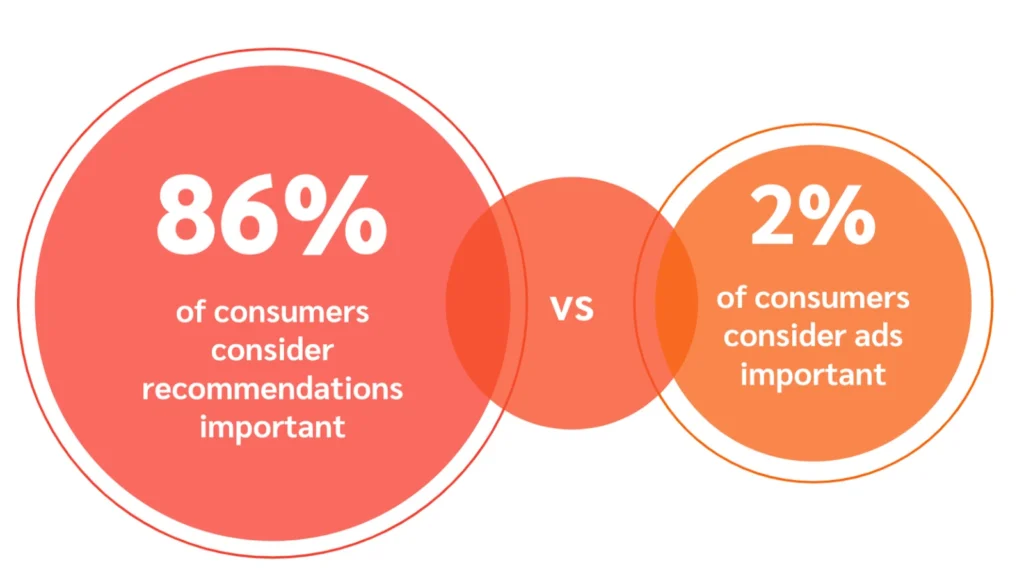
Source: Customer referral marketing research: A consumer perspective
Recommendations from someone you know feel more authentic and reliable. You can capitalize on this authenticity by encouraging happy customers to become your most loyal brand ambassadors.
2. Achieve cost-effective customer acquisition
Word-of-mouth programs are a good way to beat budget blues. Research highlights that these strategies drive up to 20 percent of total revenue for some brands while reducing customer acquisition costs (CAC).
Unlike paid ads, which require upfront payment regardless of results, brands reward customers after a successful action, such as a sale. Since you only pay for actual results, your return on investment (ROI) improves. An added bonus—referred customers tend to have higher lifetime value, boosting long-term profitability.
3. Reach shoppers that are ready to purchase
Leads from referrals tend to be more qualified than those from traditional ads. Existing customers will likely recommend your brand to friends and family with similar interests and buying intent. Referred shoppers are already primed to convert. Additionally, 39 percent of consumers say their loyalty increases after referring.
4. Drive scalable growth
Customers who love your product will naturally refer others more and more. Over time, this creates a self-sustaining cycle of customer acquisition and retention, driving consistent growth without increasing acquisition costs.
5. Achieve better revenue generation
Customer advocacy drives consistent and scalable revenue growth. The State of Referral Marketing Report highlights that customer advocacy programs generate more qualified leads and higher conversion rates than other channels. Referred customers spend more and stay loyal longer, creating a positive growth cycle. Strong incentives and streamlined program management increase participation rates, driving higher revenue without increasing customer acquisition costs.
How does a referral program work for retail?
Referral marketing allows your existing customers to promote your brand to their network in exchange for rewards. It typically involves:
- Signup: Customers join the program, usually by creating an account.
- Unique referral link or code: Customers get a personalized link or code to share.
- Incentives: Customers receive a reward (like discounts or store credit) after the referred person makes a purchase.
6 steps you can follow to create a revenue-driving retail referral program
Creating a successful referral program requires the right structure, strategy, and execution. A fun-to-use and well-designed program helps attract new customers, increase retention, and boost long-term revenue.
Follow these six actionable steps to build a referral program that drives real results.
1. Check if your retail business is mature enough for a referral program
Do a pulse check to see if your business is ready to take on the challenge of a referral program. A successful program needs the right infrastructure, a mature product, an engaged customer base, and ongoing tracking capabilities.
Ask yourself the following questions:
- Is your product/service stable? Programs work best when your product is well-received, and not in the early testing stages.
- Do you have a feedback loop? Strong customer feedback helps refine the program and resolve issues.
- Can your team support it? Your marketing and operations teams need to be ready to track, promote, and adjust the program.
- Is your customer base large enough? Programs typically succeed when your revenue is in the mid-millions and customer engagement is high.
2. Set clear referral program goals and track relevant metrics
Your program’s goals are the roadmap to advocacy success. Without a strategic plan, you’ll get lost along the way. Stay on course by tracking these metrics:
Reach and brand awareness
- Track referral traffic: Monitor the amount of traffic coming from referral links. If it’s low, adjust your incentives or outreach.
- Monitor social shares: Encourage customers to share more by offering bonus rewards for social engagement.
- Check impressions and clicks: If people aren’t clicking, tweak your call-to-action or program messaging.
New customer acquisition
- Referral conversion rate: Track how many referred visitors actually convert. If it’s low, simplify the sign-up process.
- Cost per acquisition (CPA): Keep CPA lower than the customer lifetime value (CLV) to maintain profitability.
- Track new leads and customers: Consider increasing referral incentives if new customer growth is slow.
Revenue generation
- Track total revenue from referrals: Test different incentives for low referral revenue.
- Calculate reward cost per referral: The reward value should make sense compared to the revenue generated.
- Maximize customer lifetime value (CLV): Offer ongoing rewards or exclusive deals to increase CLV.
Customer retention
- Track repeat purchase rate: If referred customers don’t return, focus on post-purchase engagement.
- Measure ongoing engagement: Keep track of email open rates and promotion participation to spot improvement areas.
3. Choose enticing referral rewards for your customers
Have you ever seen a referral reward offering and thought, ‘this isn’t worth my time’? That’s how your customers feel when you offer them an irrelevant reward. Avoid chasing away potential advocates by offering rewards you know they’ll love.
Also, consider the reward value. Research by impact.com shows that consumers expect a minimum of $21 or 11 percent discount.
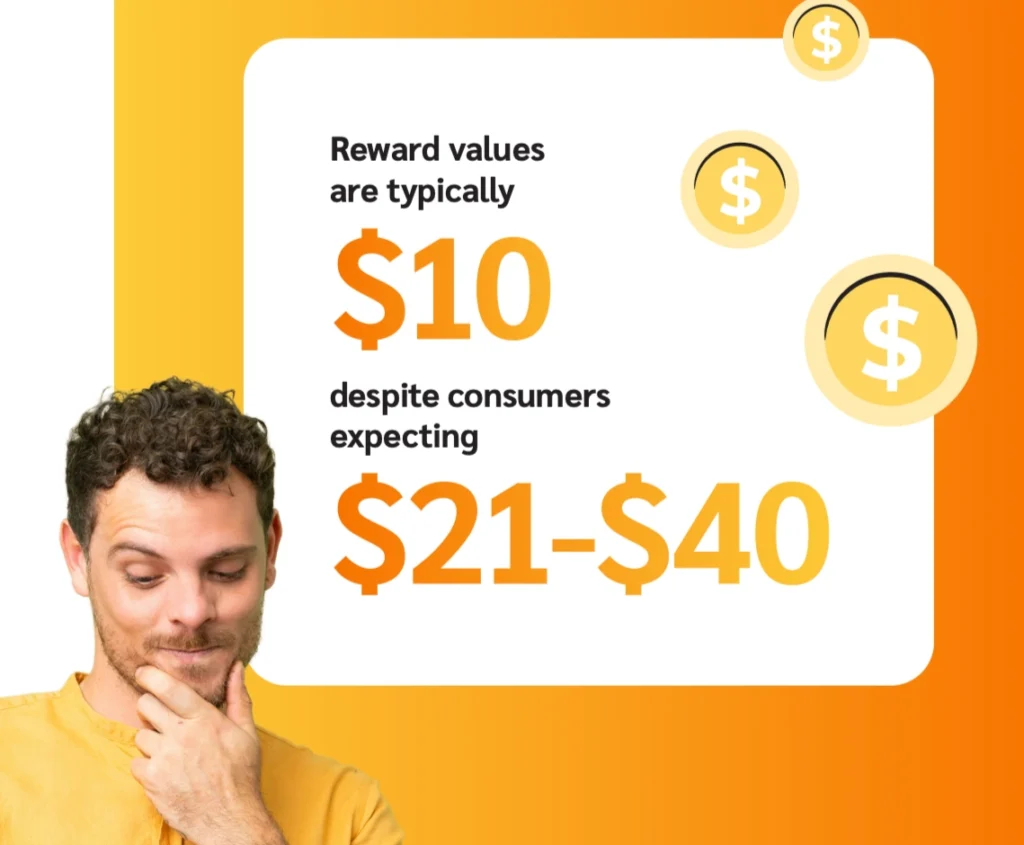
Source: Customer referral marketing research: A consumer perspective
Gathering customer feedback from surveys and sales calls is an excellent way to gauge what incentives customers are looking for.
Here are some reward types to consider for your retail business:
Double-sided reward vs single-sided rewards
Double-sided rewards: Both the referrer and the referred customer receive a reward. This incentive system creates a win-win scenario and boosts participation. Research shows that 94 percent of ecommerce and retail referral programs are double-sided because they drive higher engagement and satisfaction.
Single-sided rewards: Only the referrer or the referred customer receives a reward. While simpler to manage, single-sided programs may see lower participation rates since they lack the mutual benefit that motivates both parties. Single-sided programs are more common in the B2B SaaS vs. B2C space. Additionally, 96 percent of single-sided programs reward the referrer.
Pro vs. con of single-sided programs:
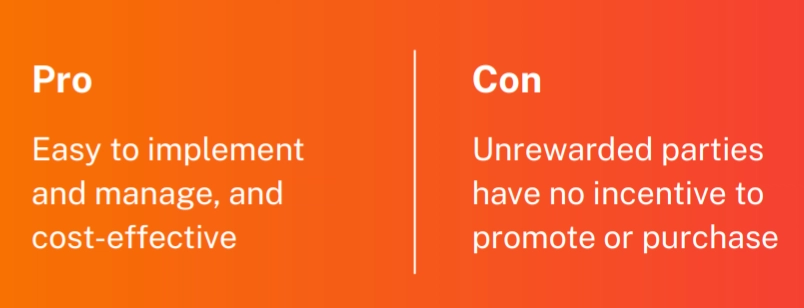
Source: The state of referral marketing report 2024
Cash rewards
Who doesn’t love a few extra bucks in their wallet? Programs like PayPal offer cash bonuses to the referrer and new customer, making participation simple and motivating.
On the downside, cash incentives can increase costs and may not build long-term brand loyalty—the customer doesn’t use the reward to repurchase. If you choose cash rewards, set up payouts to encourage customers to return to your store.
Percentage discount
Offering a percentage off creates a win-win scenario. New customers get a deal, and existing customers feel rewarded. Discounts work well for encouraging repeat business and increasing cart sizes. However, overly generous discounts can lower profit margins and attract deal hunters rather than loyal customers. Test different discount levels to balance motivating customers and protecting your margins.
Store credit
Store credit encourages new and existing customers to spend more, increasing lifetime value. It keeps the reward within your ecosystem, driving repeat business. However, store credit may not appeal to shoppers who prefer immediate savings or are unlikely to shop again. Offering flexible options (e.g., no expiration dates) can increase engagement.
Free gift or product
Think of how your eyes sparkle when you open a wrapped present. You can evoke similar emotions in your customers by offering a free product when they make a successful referral. Gifting works particularly well for retail, where most sold items are tangible products. However, the gift needs to be relevant to appeal to customers. Consider bundling low-cost, high-perceived-value products to decrease costs.
Loyalty points
Shoppers may feel like they’re playing a fun game as they rack up points. This gamified experience encourages repeat participation and long-term engagement. However, complicated point systems can confuse customers and hinder participation. Keep it simple and clearly show how many points consumers need to claim specific rewards.
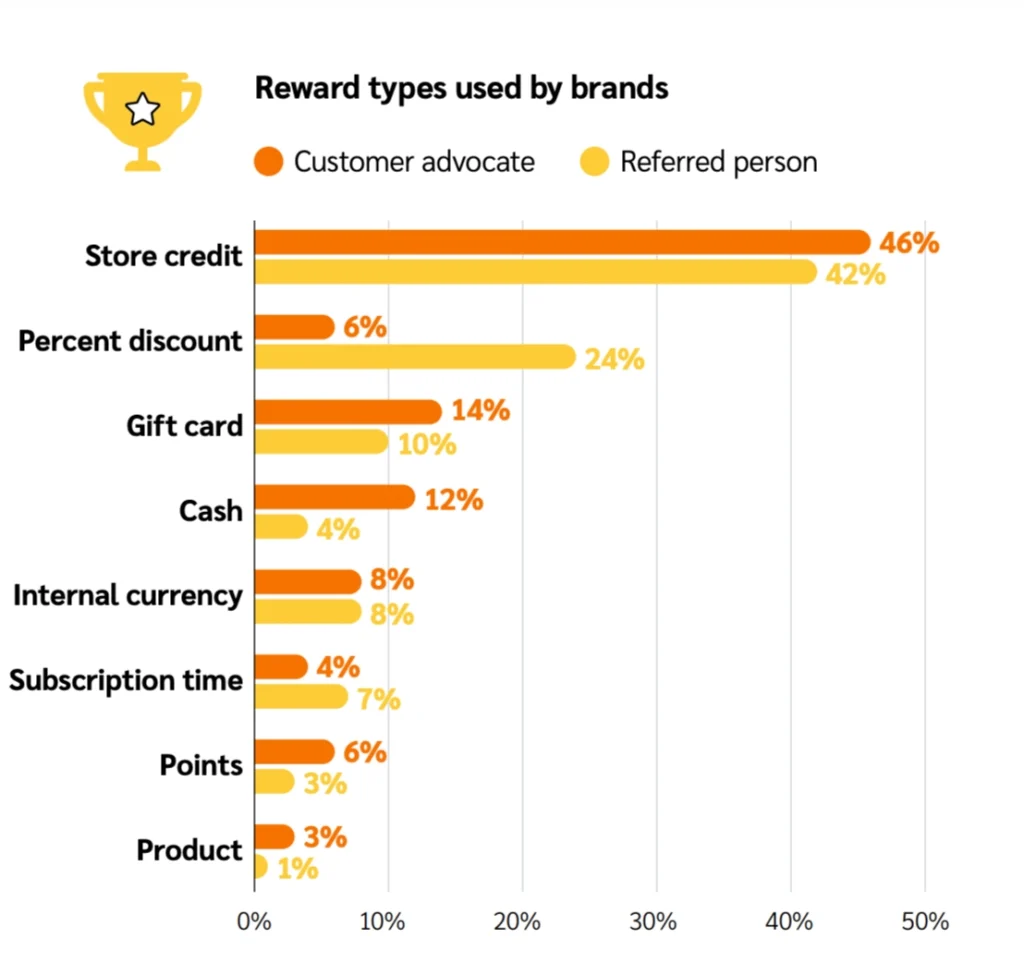
Source: The state of referral marketing report 2024
4. Promote your referral program far and wide
Don’t turn your program into a ‘Where’s Waldo?’ hunt on your website. Once your referral program is ready, you need to get the word out as quickly and widely as possible. Here are six effective strategies to drive participation:
1. Using social media and influencers
Social media is one of the fastest ways to spread the word. Share your referral program on platforms where your audience is most active, whether Instagram, TikTok, or Facebook.
Encourage customers to post about their referrals by offering bonus rewards for social shares.
You can also partner with influencers to create authentic content showcasing how easy it is to join the program and why it’s worth it. Targeted social ads can help you reach new audiences and drive more sign-ups.
2. Email marketing strategies
Email is one of the oldest forms of digital marketing. And for good reason—it works. Email marketing campaigns have an average ROI of 36 times.
Start with a dedicated email campaign announcing the program, highlighting referral benefits, and including a clear call to action (like “Refer a Friend Now”).
Keep the program top of mind by mentioning it in your regular newsletters and customer updates. You can also create a referral-specific email series to remind customers about the exciting rewards on offer. Test different subject lines, calls to actions, and email formats to refine your strategy and improve open and click-through rates.
3. In-app and on-site promotions
With over 6.3 billion smartphone users worldwide, it’s no surprise that the mobile app industry is thriving.
Take advantage of this mobile craze by placing your program front and center on your app and website. Use banners, pop-ups, and sidebar widgets to promote in high-traffic areas, like your home page or checkout page. Keep the message simple and direct, highlighting the key advantages and reward value to encourage sign-ups.
4. Explainer page
More than half of people (56 percent) haven’t participated in a referral program before, of which 12 percent have never heard of one. These stats highlight the importance of referral education.
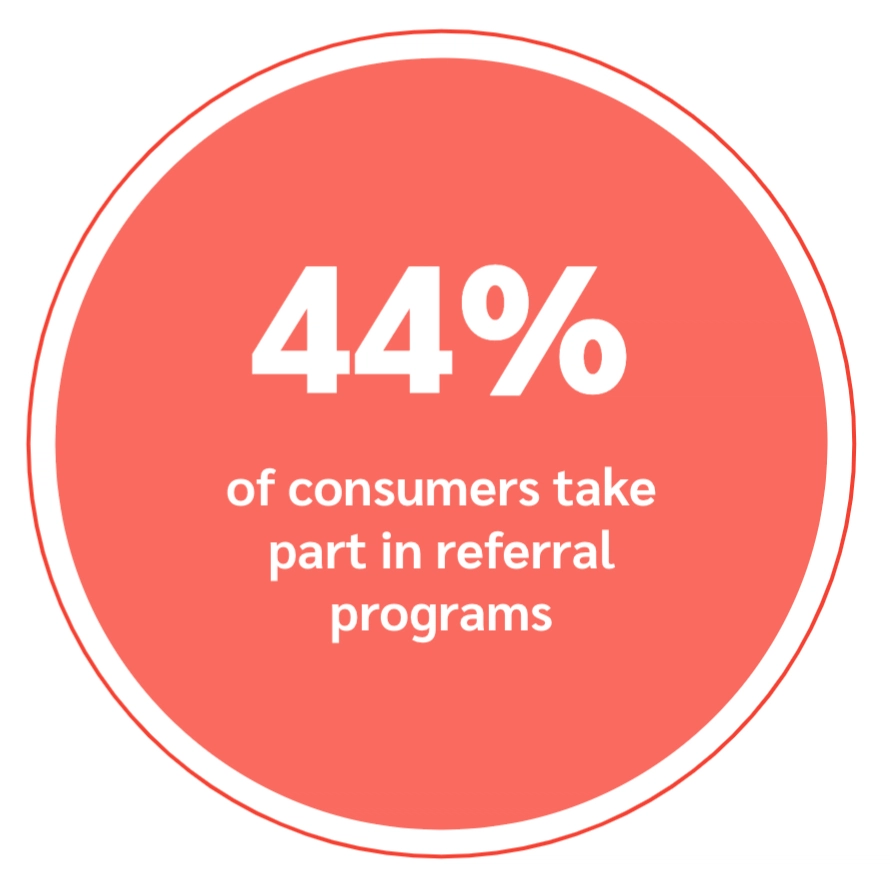
Source: Customer referral marketing research: A consumer perspective
Create a dedicated referral program page on your website that clearly and succinctly explains how your program works. Outline the participation steps, reasons for joining, and terms and conditions. Using customer testimonials or examples of successful referrals can give a further nudge.
5. Blog posts
Blog posts may not be your first thought when promoting your customer advocacy campaign. But blogs are a tried and tested way to spread the word. Create content that showcases how the program works, provides success stories from existing customers, and tips on making successful referrals. This content improves your program’s search visibility, driving more organic traffic to your referral page.
6. Integrate the program into the sales department
Your sales team is one of the key forces for driving revenue. So why not use their unique persuasion skills to promote your customer advocacy program?
Encourage your sales team to mention the referral program during customer interactions. Train them to explain how the program works for the referrer and the referred customer. This step will help drive participation and reinforce the program’s value at key touchpoints.
5. Measuring the success of your retail referral program
Once your program runs, tracking performance and adjusting your strategy based on the results is essential.
Analyze referral rates
Use your referral software to track individual customer activity and overall program performance. Focus on:
- Number of referrals initiated: How many referral attempts are being made?
- Who’s referring whom: Are certain types of customers referring more often?
- Referral completion rate: How many referrals lead to a successful purchase?
- Rewards earned: Are customers motivated enough to earn multiple rewards?
Reviewing these insights will help you identify what’s working and where to adjust.
Evaluate customer engagement and retention
Tracking engagement and retention helps you see the big picture of your referral program. Monitor how frequently referred customers engage with your brand through repeat purchases, email open rates, and promotion participation. High retention rates indicate your program attracts the right kind of customers.
Track referral links and codes
Using a platform like impact.com/advocate, you can track and analyze referral program performance in detail. The referral platform provides a customizable dashboard where you can:
- Monitor who referred whom and how many referrals were completed
- Track the value generated from each referral
- View individual participant activity, including rewards earned
- Pull custom reports to analyze performance trends and identify opportunities for improvement
- Automate follow-ups and track real-time conversion data
6. Optimize your retail referral program with data
Remember, word-of-mouth campaigns aren’t ‘set-it-and forget-it’ strategies. You need to analyze performance regularly and adjust based on data.
Analyze key performance trends
Focus on metrics such as referral conversion rates, the lifetime value of referred customers, and the number of active referrers. Adjust your approach if conversion rates drop or rewards aren’t driving engagement.
Segment and study customer behavior
Identify which demographics refer the most and which groups need more incentives. Tailor your strategy based on these insights.
Gather and implement feedback
Ask referrers and referred customers what they like and where they experienced friction. Use this feedback to breathe new life into your program.
Use impact.com to optimize
Using impact.com, get real-time insights to improve your referral program’s performance. You can:
- Track referral trends: See which rewards and referral types drive the most engagement.
- Segment customer data: Identify which customer groups are referring the most, and adjust your targeting.
- Monitor conversion rates: Analyze which referral channels work best, and adjust incentives accordingly.
- A/B test different strategies: Test different rewards and messaging to see what drives the highest participation.
Case studies: How 3 retail brands made a splash with their referral programs
Learning from successful examples is one of the best ways to refine your referral program strategy. These three retail brands have built highly effective referral programs that drive customer acquisition, increase engagement, and boost revenue.
Each program takes a different approach, from stackable rewards to percentage discounts and loyalty points, showing how tailored incentives can lead to long-term success.
Here’s how three brands made a huge impression with their customer referral programs.
Peloton uses a stackable reward system to entice customers
Peloton, known for its high-end fitness equipment and subscription-based workout classes uses a stackable reward system.
- How it works: Peloton customers receive $100 off their next purchase when they refer a friend, and the new customer also gets $100 off their purchase.
- Stackable rewards: Customers can refer up to six friends per year and earn up to $600 in credits annually.
The stackable nature of the program encourages repeat engagement and drives higher customer lifetime value.
TOMS offers percentage discounts to draw in new and old customers
TOMS, a footwear and apparel brand known for its “One for One” giving model, uses a percentage-based ecommerce referral program to reward both new and existing customers.
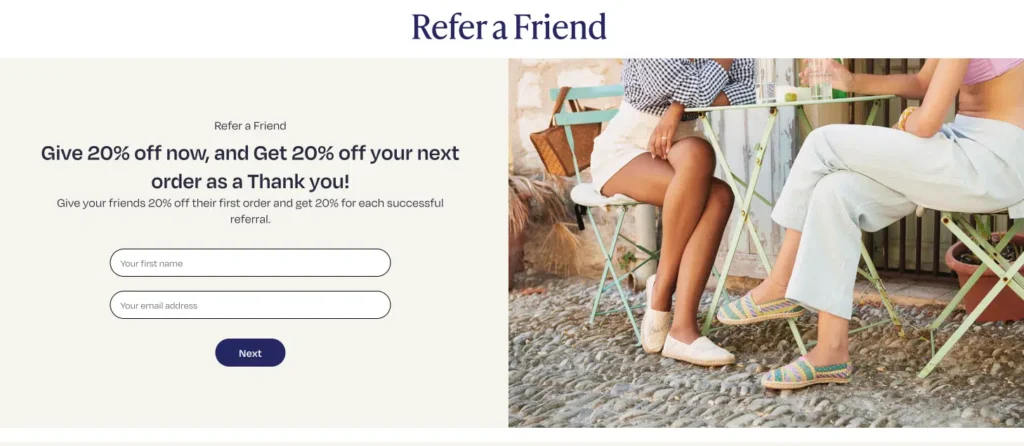
How it works: When a customer refers a friend, both the referrer and the new customer receive a percentage discount on their next purchase.
Why it works: Percentage discounts are effective because they require a purchase to claim the reward, increasing customer engagement and driving repeat sales. Referral marketing statistics shows that six percent of referral programs using percentage discounts reward the referrer, while 24 percent reward the referred customer—making this model highly effective for customer acquisition and retention.
Yolofoods gives loyalty points to create ongoing excitement
Yolofoods, a health-focused food delivery company, runs a loyalty-based referral program to encourage ongoing customer engagement.
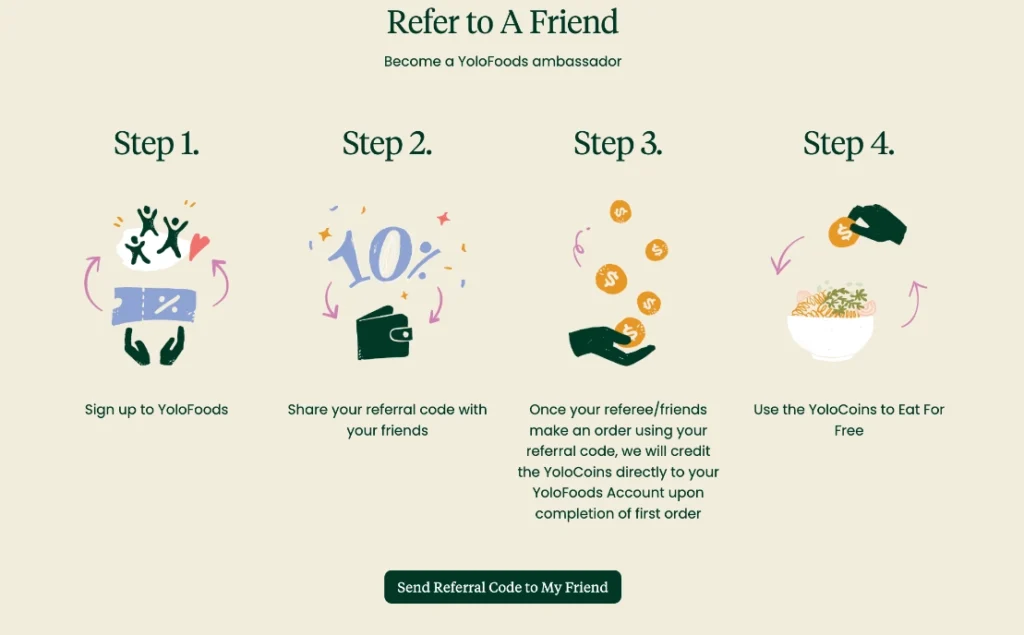
How it works: Customers earn points for referring friends, making purchases, and following Yolofoods on social media. They can redeem points for discounts or free products.
Why it works: An interactive system creates ongoing motivation by rewarding multiple actions—not just referrals. Customers stay engaged with the brand and are likelier to continue shopping to accumulate points.
Start driving sales with a winning referral program
In the oversaturated world of retail, you can’t afford to be complacent with reaching new customers. Word-of-mouth marketing can help you stand out with enticing freebies and discounts.
If you haven’t started a referral program, or you have one that’s not performing well, now’s the time to step it up. Create a program that drives real results by choosing the right rewards, promoting effectively, and tracking performance.
Ready to launch and optimize your referral program? Sign up for a free demo of impact.com/advocate and see how easy it is to manage and scale.
FAQs:
Referral marketing for retail is when businesses encourage existing customers to refer new customers in exchange for a reward. This could be a discount, store credit, or other incentive. When the referred customer makes a purchase, both the referrer and the new customer (in some cases) receive a benefit. It’s a cost-effective way to grow your customer base and build loyalty.
To create a successful retail referral program, you need to make it easy and rewarding for customers to participate. The referrer and the referred customer need a clear structure to understand the process and feel motivated to engage. Here’s how to structure it:
- Set clear goals: Define your goal (e.g., new customers, higher retention).
- Choose rewards: Decide between cash, discounts, store credit, or points.
- Design the process: Make it easy for customers to refer and redeem rewards.
- Promote it: Use social media, email, and in-store signage to spread the word.
- Track performance: Monitor referral rates, customer engagement, and ROI to adjust as needed.
The right time to launch a referral program is when your business is stable and has a loyal customer base. If your product or service is still in the testing phase or customer retention is low, it’s better to wait. Strong customer satisfaction and steady revenue indicate that your business is ready to benefit from a referral program.





